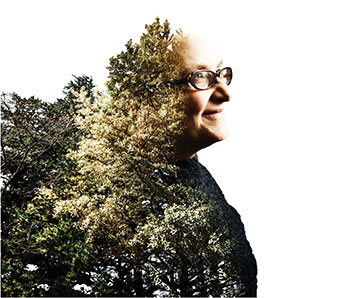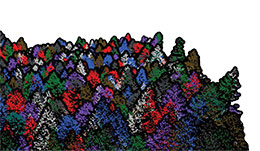Volume 32 · Number 2 · Spring 2015
From pines to pixels
3-D modeling research by Nina Amenta helps map evolutionary trees and the surface of forests.
For many, a forest’s beauty lies in its verdant abundance. For Nina Amenta, the splendor of timberlands — and their scientific mystery — are found in their intricate shapes.

(Photo illustration by Russ Thébaud/UC Davis)
“From an airplane, forests look like a sea of green foam, unlike the flat surfaces and sharp angles of cities,” Amenta said. “They’re more complicated, shape-wise, and less studied, so they’re a fascinating challenge in a 3-D data capture.”
The chair of the Department of Computer Science and holder of the Tim Bucher Family Chair, Amenta is an internationally renowned researcher of the geometry used in making 3-D computer representations of the world. Her computer simulations of nature could play a key role in protecting the world’s forests and balancing the global carbon budget.
Amenta started early with computers, which was unusual back in the days of mainframes. In high school in Pittsburgh, an art classmate told her about a local university’s youth computer club. She was also interested in geometry, devising repeating patterns to create drawings in the style of artist M.C. Escher and learning about the mathematics that governed them.
Girl programming power
“Go Turtle! Go Turtle!” Malaysia Hilliard, right, chanted with her American Canyon Middle School teammates as their robot slowly crossed an obstacle course at the ARC Pavilion.
The state of computer graphics was much too primitive at the time to make an automatic Escher program, but the concept stayed in the back of her mind through an undergraduate degree at Yale University in classical civilization and a decade-plus career in the software industry. Amenta’s idea finally came to fruition during her computer science graduate studies at UC Berkeley when she wrote Kali — a drawing program that in the early 1990s was as popular with children and artists as it was with mathematicians. Kaleido Paint, a more advanced version by the mathematician Jeff Weeks, is now an iPad app.
After earning her doctorate, Amenta did postdoctoral research at the National Science Foundation’s Geometry Center and at Xerox PARC, then taught and researched computer science at the University of Austin, Texas, before joining UC Davis in 2002.
Along the way, Amenta became interested in discovering how graphics could be used for the greater good. In 2005, she got the opportunity to find out.
She received a Chancellor’s Fellow award, which provides $25,000 to faculty early in their careers and is supported by annual giving from alumni and friends. The funding helped support her first major project to depart from pure graphics and delve into analysis, capturing shape data from fossilized monkey skulls and relating the skull shapes to evolutionary trees.
Her selection as a Chancellor’s Fellow also opened doors for new collaborative efforts. Today, she is the UC Davis director of the multicampus UC Center for Information Technology Research in the Interest of Society (CITRIS). Her knack for connecting with diverse research partners is resulting in big-data breakthroughs across disciplines.
“Professor Amenta’s 3-D modeling algorithms are having important implications in the realms of evolutionary morphology, patient imaging and telemedicine,” said Enrique Lavernia, dean of the College of Engineering. “Her work with CITRIS is equally relevant to statewide efforts at water conservation and the development of an intelligent electrical grid.”
More recently, Amenta has turned her attention to forests and their role in tempering climate change.
“Growing forests is one of the few ways we can pull carbon out of the atmosphere,” said Amenta. “However, figuring out how much carbon is stored in a given forest is not easy. It depends on the number of trees, what species they are, the size of their trunks, and other factors — all of which can be depicted in a good 3-D map. But, until now, we haven’t had the data to do so.”
In 2013, Amenta was named chair of the computer science department and holder of the Bucher Family Chair, created by Silicon Valley entrepreneur Tim Bucher ’84 and his wife, Mary Louise, to foster innovation and entrepreneurship among students and faculty in the College of Engineering.
The endowed funding has allowed Amenta to support two graduate students in developing ways to analyze LiDAR laser-light mapping data of forests. That data is collected by flying over a forest with a device that fires more than 105,000 laser pulses per second, recording a data point for every surface the laser hits.

With the help of endowed funding, graduate students in Amenta’s lab have been improving the clarity of images created from laser-light mapping data of forests.
The resulting 3-D cloud of points is difficult to visually interpret, so student Lance Simons created a sketch-like way of depicting tree silhouettes more clearly. He presented a paper on this method at a workshop on visualization in environmental sciences in England. Building upon Simon’s work, student Stewart He has identified individual species of trees and classified tree structures. He shared his results at the 2014 ForestSAT conference in Italy. Amenta and her lab, ultimately, are seeking a way to quantify how much carbon a particular forest is removing from the atmosphere.
He said he came to UC Davis, in large part, for the opportunity to do research with Amenta. “I saw some of the work Professor Amenta’s lab published when I was an undergraduate at UC Berkeley. Meeting her and visiting her lab made it very easy to choose UC Davis for graduate school.”
Amenta, in turn, said her endowed chair made it easier for her to mentor students like Simons and He — and to advance the forests research.
“When you step up to being department chair, it takes a lot of time and energy, and at the same time you want to maintain the rigor of your research program that you’ve trained all your life to conduct,” she said. “The Bucher Family Chair enabled me to take on greater responsibilities while pursuing my passion and training the next generation of computer scientists.”
A new matching program, the UC Davis Endowed Faculty Leadership Initiative, will create 25 new professorships and chair positions for other leading faculty like Nina Amenta.
